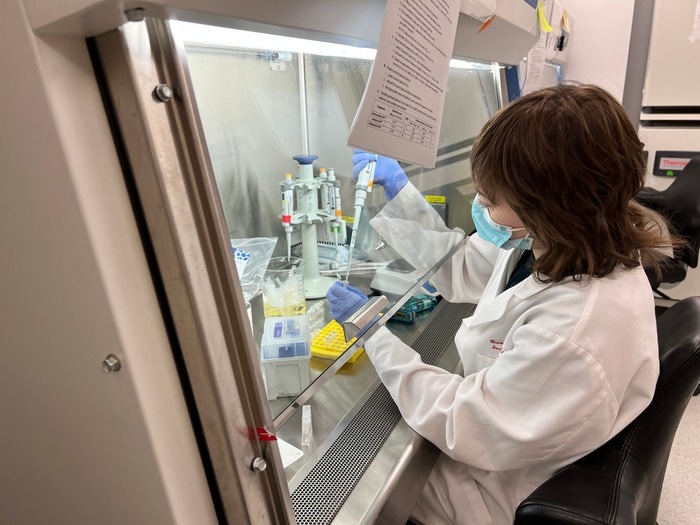The Black Death, which wiped off up to 50% of the European population in less than five years, was the single-worst mortality catastrophe in recorded history.
 A member of the Barreiro lab works in the tissue culture hood. Image Credit: UChicago Medicine
A member of the Barreiro lab works in the tissue culture hood. Image Credit: UChicago Medicine
A significant selective pressure was exerted on the human population during one of the darkest periods in recorded human history, according to new research from the University of Chicago, McMaster University, and the Institut Pasteu.
The global bubonic plague pandemic, which was brought on by the bacterium Yersinia pestis, killed 30-60% of people in cities throughout North Africa, Europe, and Asia. This had a significant impact on the human race, along with its DNA.
This was a very direct way to evaluate the impact that a single pathogen had on human evolution. People have speculated for a long time that the Black Death might be a strong cause of selection, but it is hard to demonstrate that when looking at modern populations, because humans had to face many other selective pressures between then and now. The only way to address the question is to narrow the time window we are looking at.”
Luis Barreiro, Study Co-Senior Author and Professor, Genetic Medicine, University of Chicago Medical Center
The scientists studied ancient DNA samples from the bones of over 200 people from London and Denmark who died before, during, and after the Black Death plague raged over the area in the late 1340s as part of the study, using current advancements in sequencing technology.
They discovered four genes that, depending on the variation, either protected against or enhanced vulnerability to Y. pestis using targeted sequencing for a group of 300 immune-related genes.
Barreiro added, “This is, to my knowledge, the first demonstration that indeed, the Black Death was an important selective pressure to the evolution of the human immune system.”
One gene, ERAP2, with a particularly significant link to vulnerability was the focus of the research team.
In contrast to another variant that resulted in a truncated and non-functional version of the transcript, people with two copies of a particular genetic variant, known as rs2549794, were able to make full-length copies of the ERAP2 transcript, thereby making more of the functional protein.
The immune system is assisted in recognizing an infection when ERAP2 is functional.
“When a macrophage encounters a bacterium, it chops it into pieces for them to be presented to other immune cells signaling that there is an infection. When a macrophage encounters a bacterium, it chops it into pieces for them to be presented to other immune cells signaling that there is an infection,” added Barreiro.
The scientists even went so far as to investigate how the rs2549794 variant affected living human cells’ capacity to aid in the battle against the plague, concluding that macrophages expressing two copies of the variant were more effective at neutralizing Y. pestis than those lacking it.
Examining the effects of the ERAP2 variants in vitro allows us to functionally test how the different variants affect the behavior of immune cells from modern humans when challenged with living Yersinia pestis. The results support the ancient DNA evidence that rs2549794 is protective against the plague.”
Javier Pizarro-Cerda, Director, World Health Organization Collaborating Centre for Plague, Institut Pasteur
Pizarro-Cerda is also the head of the Yersinia Research Unit.
The researchers went on to say that the selection for rs2549794 is a result of the delicate balancing act evolution has imposed on our genome. While ERAP2 protected against the Black Death in ancient populations, the same variant is now linked to an increased risk of autoimmune diseases, including Crohn’s disease, in modern populations.
Diseases and epidemics like the Black Death leave impacts on our genomes, like archeology projects to detect. This is a first look at how pandemics can modify our genomes but go undetected in modern populations.”
Hendrik Poinar, Study Co-Senior Author and Professor, Anthropology, McMaster University
“These genes are under balancing selection—what provided tremendous protection during hundreds of years of plague epidemics has turned out to be autoimmune related now. A hyperactive immune system may have been great in the past but in the environment today it might not be as helpful,” added Poinar.
In the future, the project will be scaled up to examine the entire genome rather than just a subset of immune-related genes, and the team plans to investigate genetic variations that affect bacterial susceptibility in modern humans and compare them to these ancient DNA samples to see if those variations were also the result of natural selection.
Barreiro added, “There is a lot of talk about how pathogens have shaped human evolution, so being able to formally demonstrate which pathways and genes have been targeted really helps us understand what allowed humans to adapt and exist today. This tells us about the mechanisms that allowed us to survive throughout history and why we are still here today.”
Source:
Journal reference:
Klunk, J., et al. (2022). Evolution of immune genes is associated with the Black Death. Nature. doi.org/10.1038/s41586-022-05349-x